Stay in the know on all smart updates of your favorite topics.
To keep Amsterdam liveable the municipality collaborates with its citizens. On average Amsterdam’s population grows with 10.000 people a year. This small big city has a density of 5065 people per square km, over 180 different nationalities. 19% of the total Dutch GDP is earned in the Amsterdam Metropolitan Area. Between 2015 and 2016, the amount of tourists in Amsterdam increased by 7%. To keep Amsterdam’s 162 canals, monumental centre and residential areas liveable, innovative initiatives are required. Share your innovative concepts and ideas here!
Energy Lab Zuidoost

Amsterdam Zuidoost aims to be energy neutral by 2040. To reach this goal, significant steps need to be taken. Not only do we need new technologies, there is also a need for smart ways to organize the transition, and for adaptations to our lifestyle. This requires cooperation among many different parties. Both from the government and residents, as well as from companies and researchers. Energy Lab Zuidoost brings these parties together.
Energy Lab Zuidoost
The Energy Lab Zuidoost is an initiative of the AMS Institute, the City of Amsterdam and the Urban Energy Institute of TU Delft. By experimenting together in different ‘Living Labs’, they develop and test new innovations in a real-life environment. This helps understand what works and how to scale and implement these innovations in Amsterdam Zuidoost and other metropolitan environments.
The Energy Lab Zuidoost ensures the exchange of knowledge between different projects, organizations and disciplines. It connects scientific expertise to the urban challenges in Zuidoost and brings together academics from various disciplines. The ambition is to share the knowledge, so the innovations can be applied throughout Amsterdam and beyond.
Energy Lab Zuidoost focuses on three main topics around which they develop pilots and experiments:
- The sustainable renovation of homes
- Low temperature heat networks
- Local smart energy systems
For more info see the full animation about Enegry Lab Zuidoost (Dutch with English subtitles) on the AMS website >>
Interactive Sound Garden @ Marineterrein
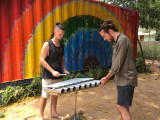
Hello smart city lovers! What do you think of this proposal for a Sound Garden @ Marineterrein?
We are proposing a welcome and open place of musical exploration and reflection for all Amsterdammers and visitors to Marineterrein.
It invites you to stay and play, to enjoy the wonder of sounds, and to discover music inside yourself.
NEW EUROPEAN BAUHAUS PARTNERSHIP FOCUSES ON A SUSTAINABLE FUTURE

The Amsterdam University of Applied Sciences (AUAS) has become an official partner of the European Commission's New European Bauhaus (NEB) initiative, which aims to transform the European Commission's sustainability agenda into real solutions that contribute to a sustainable and inclusive society. This partnership is coordinated via the AUAS’s Centre of Expertise for Creative Innovation (CoECI), a collaboration between four Amsterdam-based higher education institutions that is headed by AUAS. By participating in this initiative, AUAS and CoECI will focus on helping to create a sustainable and inclusive society through creative innovations with a broad network of partners.
New European Bauhaus stems from the Horizon 2020-funded European Green Deal, the latter of which aims to accelerate Europe's recovery from the coronavirus crisis by turning green challenges into innovation opportunities. Within the Green Deal, AUAS is already working on various project proposals with international partners that aim to help create a climate-neutral Europe by 2050 via our collaborative applied research. These EU initiatives align well with our new 3D strategy at the Amsterdam University of Applied Sciences, which prioritises sustainability as one of the three key domains for our institution in the years ahead, alongside diversity & inclusion, and digitalisation.
Beautiful, sustainable, together
Via the motto ‘beautiful, sustainable, together’, AUAS partners with New European Bauhaus New European Bauhaus (NEB) draws inspiration from Bauhaus movement 100 years ago and the belief that design can be a force for societal progress. To quote the project: “We want to create a design movement integrating three dimensions: sustainability (including circularity), quality of experience (including aesthetics) and inclusion (including affordability). Showing that creativity is in finding affordable, inclusive and attractive solutions for our climate challenges.”
The interdisciplinary nature of the initiative presents an excellent opportunity for the entire AUAS, and the creative sector in particular, to participate and help shape the future. CoECI supports this plan and, together with its network of partners both inside and outside the AUAS, will use its imagination and develop innovative concepts that contribute to the sustainable transition.
Activities
In the coming months, CoECI will join other partners in the Netherlands and Europe to discuss ideas for a sustainable future and how the creative sector can contribute to it. It will also review how faculties across the AUAS can collaborate on this great challenge from their own areas of expertise: from social questions and technical innovations to design perspectives.
CoECI brings together creative businesses, citizens, science and education in the Netherlands and Europe, to collectively create proposals and ideas for a sustainable Europe. The NEB initiative is now in the 'Design phase' and will kick off the 'Deliver phase' in September 2021. The AUAS hopes to be selected for this, which would see it set up and implement collaborative pilot projects. This will be followed by the 'Disseminate phase'. More information, including about the activities, will soon be available on the CoECI website (currently only available in Dutch).
Contact
Mareile Zuber, project developer at CoECI and responsible for the European partnership, is the contact person for questions/remarks/ideas and proposals regarding New European Bauhaus. You can reach her directly via m.a.zuber@hva.nl.
In addition to coordinating activities for New European Bauhaus, Mareile will focus on building bridges between CoECI/AUAS and other European consortia. This could include, for example, applications to European financing programmes such as Horizon Europe, Creative Europe and Digital Europe.
About the Centre of Expertise for Creative Innovation
The Centre of Expertise for Creative Innovation (CoECI) is the national knowledge and innovation network for the creative industry. CoECI uses art, media, technology and design to create a sustainable and inclusive urban society. These activities contribute to partnerships, both commercial and non-profit, between education and the professional field. In this way, CoECI connects research and talent with companies, social organisations and communities.
CoECI is a partnership coordinated by the Amsterdam Universities of Applied Sciences with three other institutions: the Amsterdamse Hogeschool voor de Kunsten (AHK) and Hogeschool Inholland (founding partners); as well as the Gerrit Rietveld Academy, which joined the collective in 2019. This collaboration was originally launched under the name Amsterdam Creative Industries Network (ACIN). CoECI covers the entire chain of artistic innovation: from experimental research to concrete interventions.
More information about New European Bauhaus is available via the website of the European Commission.
Interview met Marco Te Brömmelstroet, prof Urban Planning (UvA)

Interview met Marco Te Brömmelstroet, prof Urban Planning (UvA) en co-auteur boek 'Recht van de Snelste'. ‘Reistijdwinst is DE norm onder alle uitroeptekens qua mobiliteit, maar vragen amper naar de onderliggende aannames’.
(Herhaling vanuit #BNR podcaststudio: opnieuw relevant dit interview): https://bit.ly/Brömmelstroet
Q&A about Amsterdam Science Park
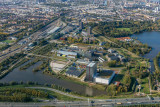
What is really so unique about Amsterdam Science Park? Who is working here or carrying out research? How did we get here? What are the long-term development plans for the park? What are the key trending issues in the industry? Which of the institutes and businesses based here could be of particular interest to your company?
During these monthly online sessions, we will lead you into the world of Amsterdam Science Park. No matter if you’re new to the science scene in the Amsterdam Area or you’ve been working here for years, it’s a fantastic way to learn about the ins and outs of the park and the innovations taking place here. It’s also a great way to introduce yourself, without any obligation. Pose a question in the next session and maybe you’ll find yourself part of a fascinating conversation that transforms your own business or outlook.
Circulair ondernemen in Noord-Holland

Provincie Noord-Holland en Impact Hub Amsterdam werken samen om het circulaire ecosysteem van de provincie te versterken. Vanaf 29 april 2021 tot 3 feb 2022 organiseren we maandelijkse expertsessies, netwerkevenementen en masterclasses om je op weg te helpen met circulariteit. Het programma bestaat uit 11 gratis evenementen, waaronder 6 opeenvolgende masterclasses.
Metropolitan Mobility Podcast with Karen Vancluysen (Polis Network)
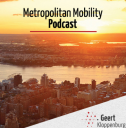
How can local governments deal with (technological) innovations? Listen to the #podcast with Karen Vancluysen of POLIS Network: https://bit.ly/mobilitypod
New European Bauhaus conference

On 22nd and 23rd April, the European Commission will host its first conference related to the "New European Bauhaus" initiative.
The New European Bauhaus is a creative and interdisciplinary initiative, convening a space of encounter to design future ways of living, situated at the crossroads between art, culture, social inclusion, science and technology. It brings the Green Deal to our living places and calls on all Europeans to imagine how we can make the places where we live and our experiences more beautiful, sustainable, and inclusive.
The conference will be held online in English. It is free of cost and registration for the first day is open to everyone.
Teken het manifest voor een Burgerberaad Klimaat & Milieu
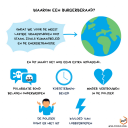
Begin dit jaar is het ‘Manifest Burgerberaad Klimaat en Milieu’ gelanceerd. Een coalitie van burgers en organisaties roept de politiek op een ambitieus burgerberaad in te stellen, waarin burgers maatregelen bedenken om de klimaatcrisis te bestrijden en biodiversiteitsverlies tegen te gaan. Ik ondersteun dit manifest van harte omdat ik erin geloof dat een grotere betrokkenheid van burgers bij deze grote uitdaging leidt tot betere en eerlijkere oplossingen. Jij ook? Teken het manifest!
De opwarming van de aarde raakt alles en iedereen. Om de aarde leefbaar te houden zijn snel grote veranderingen nodig. De Nederlandse overheid (gemeenten, provincies en Rijk) lijken nog onvoldoende in staat om tot een toereikende, integrale aanpak van de klimaatcrisis te komen. Een belangrijke barrière is dat moeilijke keuzes (bijvoorbeeld rondom de plaatsing van windmolens of het inperken van de intensieve landbouw) uit de weg worden gegaan. Ook worden burgers onvoldoende en vaak veel te laat betrokken bij de voorgestelde oplossingen, wat leidt tot vertraging en weerstand.
Waarom een burgerberaad?
Een burgerberaad is een onafhankelijk georganiseerde werkwijze waarbij een gelote dwarsdoorsnede van de Nederlandse bevolking zich laat informeren door experts en belanghebbenden. Vrij van lobby en verkiezingsdruk ontwikkelen zij maatregelen die eerlijk en toereikend zijn, en bovendien gesteund worden door de samenleving. Onder andere dit rapport van de OECD laat zien dat deze democratische methode in het buitenland goed werkt om hete hangijzers aan te pakken. Een belangrijke voorwaarde is dat het proces transparant wordt ingericht.
Effectief groen voor klimaatadaptatie in de stad
De HvA start onderzoek naar concrete handvatten voor klimaatbestendig en verkoelend stedelijk groen
Een groene stad is niet automatisch een klimaatbestendige stad. Groen is wel de meest effectieve maatregel tegen hittestress en kan bijdragen aan waterbestendigheid. Mits de inrichting hierop is ontworpen. Samen met Wageningen University & Research (WUR) en ontwerpbureau Niek Roozen onderzoekt de Hogeschool van Amsterdam (HvA) hoe een groene straatinrichting het meest effectief is voor verkoeling in verschillende wijktypen.
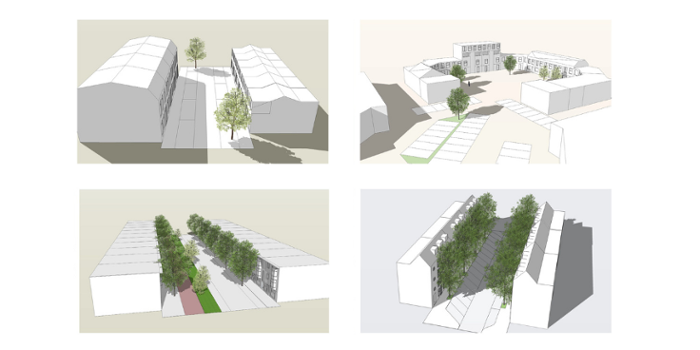
Een belangrijk praktisch aspect van het onderzoek is het waterverbruik van groen voor koeling, in samenhang met de opbouw van de bodem en de benodigde buffercapaciteit. Maar een duidelijk stappenplan hiervoor mist, stelt Jeroen Kluck, lector Water in en om de stad. ‘We krijgen vaak vragen over welk type groen het beste is tegen en bij klimaatverandering. Dit project helpt daar antwoord op te geven. Wij ontwikkelen concrete handvatten voor ontwerp, aanleg, inrichting en beheer van klimaatbestendig en verkoelend stedelijk groen.’
Vier wijktypen onder de loep
Voor verschillende soorten en ontwerpen van straatgroen onderzoeken wij enerzijds de verkoelende werking en anderzijds de kwetsbaarheid tegen verdroging. Daarbij richten we ons op vier karakteristieke en veel voorkomende wijktypen: het stedelijk bouwblok, de bloemkoolwijk, de volkswijk en een verbindingsweg. Ieder type heeft specifieke fysieke kenmerken zoals bouwhoogte, breedte van de straat en vorm van groene inrichting, welke bepalend zijn voor de mogelijkheden en effectiviteit van een nieuwe groene inrichting. De inzichten verwerken we in praktijkrichtlijnen en sjablonen voor deze wijktypen. Daarnaast werken we aan een nieuwe bomentabel waarin klimaatbestendigheid van typen bomen is verwerkt.
'Als we steden klimaatbestendiger willen inrichten willen we ook weten welk type groen het beste bijdraagt en het beste bestand is tegen die klimaatveranderingen. Super om dit samen met de mensen met groene vingers te onderzoeken' — Jeroen Kluck, lector Water in en om de stad
Interdisciplinaire samenwerking
Het project is een samenwerking tussen de groene sector, ontwerpers, landschapsarchitecten, stadsklimatologen en beheerders van het stedelijk groen. Het project is een mooie aanvulling op het onderzoeksportfolio van het HvA-lectoraat Water in en om de stad en met name de onderzoeken naar het klimaatbestendig inrichten van de stad, het hittebestendig inrichten van de buitenruimte, hittemetingen in de stad en ook het gebruik van wijktypen als basis om klimaatrisico’s en maatregelen te structureren.
Meer informatie?
Houd de projectpagina van 'Effectief groen voor klimaatadaptatie in de stad' in de gaten voor alle ontwikkelingen.
Smart City Amsterdam - Defining the future!
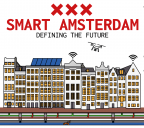
Dear AmsterdamSmartCity,
Today I start my dissertation project for Oxand. Together we will be working towards defining clearer goals for Gemeente Amsterdam's smart city objectives! We will approach this challenge by taking the #SmartCity principles and observing them through the lens of #SystemEngineering.
I am looking for members who are interesting in helping me identify stakeholders, current challenges facing the municipality, developing projects, objectives that must be fulfilled and much more!
Podcast #wandeltijdensjewerkdag
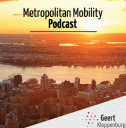
In het kader van #wandeltijdensjewerkdag op 8 april georganiseerd door Wandelnet, een podcast over lopen voor tijdens het wandelen: http://bit.ly/podcastlopen
Wat is jouw energielabel?
HvA-studenten Data Science voorspellen voor Vattenfall het energielabel voor gebouwen die dat nog niet hebben, om de energietransitie te versnellen.
Heeft jouw kantoorgebouw energielabel D? Dan is er werk aan de winkel. Om de klimaatdoelen uit het Parijsakkoord te halen en de opwarming van de aarde te beteugelen, moet de gebouwde omgeving versneld verduurzamen en vanaf 2023 minimaal energielabel C scoren. Een vernieuwd energielabel moet daarbij helpen. Maar wat als je dat nog niet hebt? HvA-studenten buigen zich voor partner Vattenfall tijdens een hackathon over de vraag: Kan voor gebouwen zonder energielabel een schatting voor een energielabel worden bepaald aan de hand van beschikbare data?

Na twee uur begaf de dataserver het al. Niet zo gek, er was haast en drukte: binnen een hackathon van een kleine week moesten de studenten van minor Data Science allemaal tegelijk de beschikbaar gestelde data over energieverbruik van Vattenfalls klanten analyseren. Met als doel: een zo accuraat mogelijk voorspelmodel voor de energielabels van gebouwen. Normaal ben je al weken lang bezig met datasets verkennen voordat je over kan gaan op opschonen, categoriseren, analyseren en voorspellen middels machine learning, stelt Rick Wolbertus, docent-onderzoeker Data Science van lectoraat Energie en innovatie. ‘Nu moesten ze dat in enkele dagen doen. Daarin zie je de kracht van een hackathon: binnen een bizar korte tijd krijg je verrassende uitkomsten; een groepje had een 84% accuraatscore in hun voorspelling voor energielabels, dat is echt knap.’
Energielabel bepalen
Van woningen tot fabriekshallen, het energielabel is een middel om de energie-efficiëntie van gebouwen te kwalificeren. Sinds begin dit jaar heeft het energielabel een metamorfose ondergaan, kent het andere kwalificeringseisen en is het bovendien verplicht geworden voor alle gebouwen. Met de nieuwe en vereenvoudigde bepalingsmethode (NTA 8800) wordt de energie-efficiëntie nu uitgedrukt in het energieverbruik per vierkante meter gebouwoppervlakte. Deze indicator is goed te vergelijken met werkelijk energieverbruik en moet beter inzicht geven in de energiezuinigheid van het gebouw. Daar kunnen maatregelen aan gekoppeld worden voor verduurzaming.
De hackathon voor energielabels is het eerste vraagstuk uit de praktijk voor studenten die voortkomt uit de tienjarige samenwerking tussen HvA Centre of Expertise Urban Technology en energieleverancier Vattenfall. De hackathon levert snel een frisse blik op, vertelt Tim Pellenkoft, data scientist bij Vattenfall. ‘De studenten, met verschillende achtergronden in onder andere journalistiek, technische bedrijfskunde en aviation, hebben andere denkbeelden die tot nieuwe inzichten leiden. Zo zagen zij patronen in bouwjaar, waar ik zelf nog niet op was gekomen. Oud bouwjaar? Vrijwel altijd een laag energielabel. Daar tegenover staan nieuwere gebouwen, die met een hoger label vaak beter zijn geïsoleerd.’
Het is aan de studenten om zulke variabelen, die invloed hebben op het energielabel, uit de data te halen. Daarin werden verrassende keuzes gemaakt, zag ook Wolbertus. ‘De data toonden enorme verschillen in verbruik tussen gebouwen van diverse industrieën. Industrieën die gigantische machines in hun gebouw gebruiken, die wil je scheiden van andere type bedrijven. Dus moet je categorieën maken en die in de voorspelling (middels machine learning-modellen) van elkaar scheiden. Zo voorkom je scheve analyses en kun je accurate verbanden leggen. Daar kwamen studenten zelf mee!’
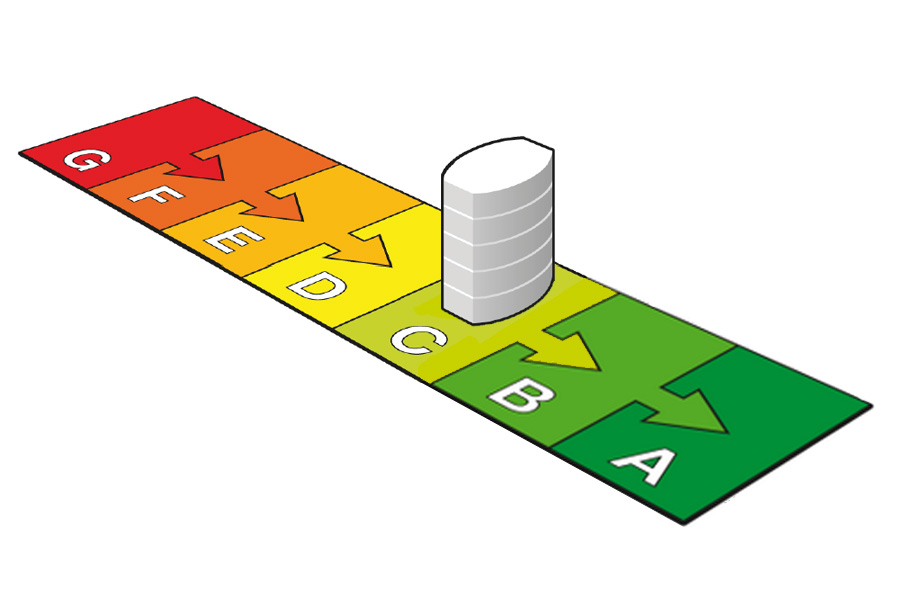
Inzicht in verbeterpotentieel voor gebouwen
De uitkomsten uit de analyses en voorspellingen van de studenten kunnen bijdragen aan een model dat energieleveranciers, gebouwbeheerders, bouw- en installatiebedrijven inzicht geeft in het verbeterpotentieel van het energieverbruik van gebouwen. Want om de klimaatdoelen van het Parijsakkoord te halen, staat de (bestaande) gebouwde omgeving nog voor een aantal uitdagingen: significante energiebesparing, zelf zoveel mogelijk energie opwekken, energie verbruiken op de momenten dat het duurzaam wordt opgewekt en het realiseren van alternatieven voor aardgas als bron van verwarming. Heb je dat op orde? Dan mag je rekenen op een ‘perfecte’ energielabel-score A+++.
Voor veel gebouwen is het nog niet zo ver. Daarom zijn data en voorspelmodellen nuttig, aldus Pellenkoft. ‘Die bieden periodiek inzicht voor onze klanten, zodat zij kunnen sturen om vanaf 2023 het verplichte energielabel C voor kantoorgebouwen te realiseren.’ En de studenten? Vattenfall gaat met vier studenten tien weken lang voortbouwen op de inzichten uit de hackathon, om tot een eindproduct te komen zoals een verbeterd voorspelmodel. Pellenkoft: ‘Zo kunnen zij meer leren over data science-projecten in de praktijk, en stomen we studenten heel gericht klaar voor werk na de studie.’
Meer informatie?
- Centre of Expertise Urban Technology
- Transitiethema Energy Transition
- Lectoraat Energie en innovatie
- Faculteit Techniek
- Energieleverancier Vattenfall
International Hackathon: Develop creative, innovative solutions for lower incomes in the energy transition
Are you a student with an interest in climate, technical and social innovations? Do you want to contribute to sustainable and affordable energy generation? Would you like to develop new concepts, products or services? Take part in the international hackathon Empower on Saturday 1 May! The hackathon offers a unique opportunity to collaborate with different students, experts and professionals. Your idea can have an impact on the social energy transition in Europe. You have a chance to win a sustainable grand prize!
Interview in bijlage FD met mobiliteitsexpert Geert Kloppenburg

Kansen en mogelijkheden deelauto- en deelfietssystemen en ophouden om mobiliteitssysteem op piekmomenten te blijven organiseren op zowel weg als spoor.
Lees het artikel hier: http://bit.ly/FDgeert
Swedish Chamber of Commerce Webinar TechTalent - Explore how to attract, retain and manage tech talents Tuesday 20 April 2021 10.00 -11.00
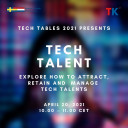
Tech Talent
Explore how to attract, retain and manage tech talents
With the acceleration in digital, the demands on technology — for
speed, flexibility, reliability, security, and value — have radically
increased. For company leaders reviewing how to transform their
organizations, one tricky question is emerging: Where do I find the
people to do all the work? Companies have to hire the best, but that
won’t be enough. They’ll also need to rethink how they reskill and
upskill their people. People are the most important factor for a
company’s growth, especially in its early stages of development. How to
find the right people and how to get a better understanding on how to
create great teams?
SPEAKERS LINE UP:
Dr. Cara Antoine, Managing Director Digital Transformation at IG&H
Bernie van Leeuwen, Managing Director SKF Netherlands
Rik Zuidmeer, Partner and member of the International Leadership Team of Mercuri Urval
Jeffrey Kenens, Partner TK
Moderator: Rens Goudsmit, Head of TK Tech & Attorney at law
For more information and to sign up for this webinar please follow the link.
Update Intelligent Cities Challenge & Opportunities To Get Involved

The 100 Intelligent Cities Challenge (ICC) is a European Commission (EC) initiative that supports 136 cities with using cutting-edge technologies to lead the intelligent, green and socially responsible recovery. The goal is to accelerate ICC cities and their local ecosystems as engines for post-pandemic recovery, creating new jobs and strengthening citizen participation and wellbeing.
The Amsterdam Metropolitan Area, represented by Amsterdam Economic Board and Amsterdam Smart City (ASC), has joined the ICC as a mentor region. A key task for ASC is to connect and share best practices from the Amsterdam region with the ICC network.
Here are a few of the upcoming opportunities for ASC partners and community members who would like to get involved in the ICC:
- Sharing best practices during the 3rd ICC City Lab, May 18 – May 21: During this four day event, ASC partners have the opportunity to contribute to various knowledge and working sessions across a range of topics including: circular economy and Local Green Deals (LGD’s), energy efficient renovation, digitalization of government services, digital twins, and citizen participation.
- Contributing to Tech4Good Marketplace:Within the scope of ICC, the EC is developing a digital platform where cities can share their experience and recommendations for validated and deployed smart city solutions. During the April - June timeframe, ASC will collect transferable solutions and best practices from the Amsterdam Region which will be shared on the Marketplace.
- Advise on the development of the European Interoperability Framework for Smart Cities and Communities (EIF4SCC): Acknowledging the importance of interoperability for smart cities and communities, the EC contracted Deloitte and KU Leuven University to develop a proposal for a European Interoperability Framework. The aim of the EIF4SCC is to provide European local administration leaders with definitions, principles, recommendations (including practical use cases) and a common model that enables public service delivery across domains, cities, regions and borders. The first draft of the Framework is open for stakeholder consultation via the following survey until April 12.
For more information about ICC or any of the above points, please contact Cornelia Dinca, ASC International Liaison via cornelia@amsterdamsmartcity.com
Meetup: Entrepreneurs share Mobility as a Common initiatives
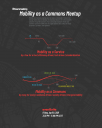
On April 9th three collective entrepreneurs present their Mobility as a Common initiatives and challenges at the Townmaking Common Labworks.
The Towmaking Common Labworks are a network of cooperative initiatives that develop and implement solutions for the common good. This Friday we start a series of meetups for the vertical in Mobility as a Commons, and invite entrepreneurs, governments and professionals to join the Labworks and build together.
This Friday WijZijnDeel and the Amsterdam Bicycle Collective will present their initiatives and journeys.
The ABC builds a local cooperative ecosystem for the development, production, maintenance, and use of community-built circular eBikes. Join the designers, engineers, bicycle shops, and educational partners in making Dutch cycling culture about care for healthy living, sustainable production, and quality making.
WijZijnDeel organises citizens in cooperatives in order to be able to provide in their collective mobility needs.
Our city urgently requires zero-emissions and lower loads on aging infrastructure, and at the same time the health of our city also needs mobility solutions that are sensitive to local needs, and that are made and maintained by highly-skilled local economies. We believe local communities are best positioned to understand their collective needs and environment, and they form the heart of a healthy, sustainable and inclusive society. Therefore our mission is to empower these communities with quality infrastructure and ownership.
Join the Townmaking Common Labworks:
When: April 9th from 15h-17h
Where: Find more info about the event and sign up at https://www.eventbrite.com/e/mobility-as-a-commons-meetup-tickets-148005619793
New podcast out !
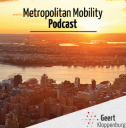
De Gouden Piramide ging in 2016 naar een bijzondere plek voor jonge mensen: Xenia Huis met een Hart Hospice en Logeerhuis Leiden. Luister naar het indrukwekkende verhaal van oprichtster Jacqueline Bouts: https://bit.ly/mobilitypod
Nooit te laat om te leren over het klimaat
‘We moeten en kunnen in Amsterdam meer ruimte geven aan klimaatadaptatie!’ Eerste Leertraject Klimaatadaptatie van Urban Technology met gemeente Amsterdam en Waternet is afgerond.
Van overstroomde straten tot dorre parken, klimaatverandering is steeds duidelijker zichtbaar in de stad. Hoe kunnen we onze steden daar tegen weren en klimaatadaptief (her)inrichten? Ruim 30 medewerkers van gemeente Amsterdam en Waternet namen deel aan het eerste Leertraject Klimaatadaptatie van lectoraat Water in en om de stad (HvA Centre of Expertise Urban Technology). ‘Veel geleerd over een integrale aanpak van maatregelen die voor meerdere klimaatthema’s tegelijk werken.’
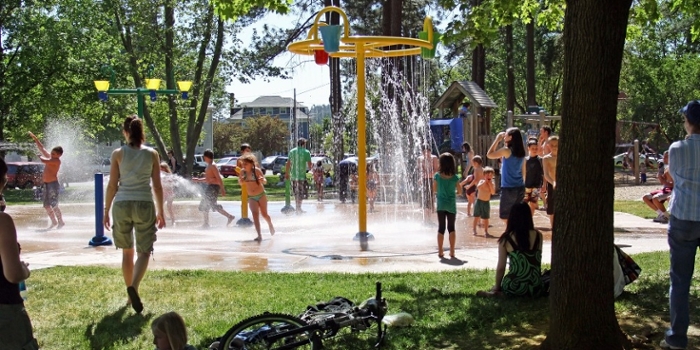
Het Betondorp in Amsterdam maakt haar naam waar: veel steen, verharding en wateroverlast als gevolg wanneer er extreme buien plaatsvinden. Maar daar is sinds kort een klimaatadaptieve oplossing voor verzonnen: wadi’s. Regenwater stroomt naar deze verdiepte groene plekken om het op te vangen en langzaam in de bodem te laten infiltreren. Inmiddels heeft Betondorp diverse vegetaties die het stadsdeel een stuk groener maken.
Van steen naar groen
Betondorp is een voorbeeld waar de Nieuwezijds Voorburgwal vooralsnog jaloers op is. Deze grote straat, die loopt van Spuiplein tot Station Amsterdam Centraal, moet opnieuw ingericht worden, vertelt Lisette Klok, docent-onderzoeker van de HvA en Leertraject Klimaatadaptatie. ‘Het is een verharde omgeving met veel schaduw, waar we meer groen kunnen creëren om ruimte te geven aan klimaatadaptatie.’ Het is een van de vele praktijkcases die ruim 30 professionals van de gemeente Amsterdam onder de loep namen op de klimaatthema’s waar we door klimaatverandering vaker mee te maken krijgen; wateroverlast, hitte, droogte en waterveiligheid.
Brede insteek voor integrale aanpak
De thema’s van het leertraject helpen om kennis over klimaatverandering te verbreden, om tot een integrale aanpak te komen bij de gemeente en Waternet, vertelt Alice Driesen, deelnemer en mede-organisator van het leertraject (werkzaam bij afdeling Ruimte en Duurzaamheid). ‘Ik werk nu aan Amsterdam Rainproof , een programma gericht op het regenbestendig inrichten van de stad. Dus kennis over wateroverlast had ik wel. Maar de effecten van hitte en droogte in de stad, hoe dat in kaart te brengen en welke oplossingen, risico's en kosten er zijn? Dat was nieuw voor mij. Bij de gemeente willen we alle klimaatproblemen in een stadsgebied tegelijk kunnen aanpakken.’
Driesen onderzocht met haar leertrajectgroep de effecten van klimaatverandering op straatniveau in het Oostelijk Havengebied van Amsterdam. Zij keken naar stresstestkaarten om te achterhalen wat er precies speelt in het gebied, vertelt Driesen. ‘Is het gebied gevoelig voor hittestress, hoe is de bodemopbouw, hoe zijn de grondwaterstanden? We verbinden bestaande databronnen aan elkaar voor een completer beeld, zoals peilbuismetingen voor de grondwaterstanden om te achterhalen of er risico is op paalrot bij oude panden. Vervolgens koppelen we er concrete maatregelen aan. In onze diverse leertrajectgroep, van stedenbouwkundigen en ontwerpers van de openbare ruimte tot maaiveldwerkvoorbereiders en assetbeheerders, konden we elkaars expertises bundelen en tot integrale oplossingen komen.’
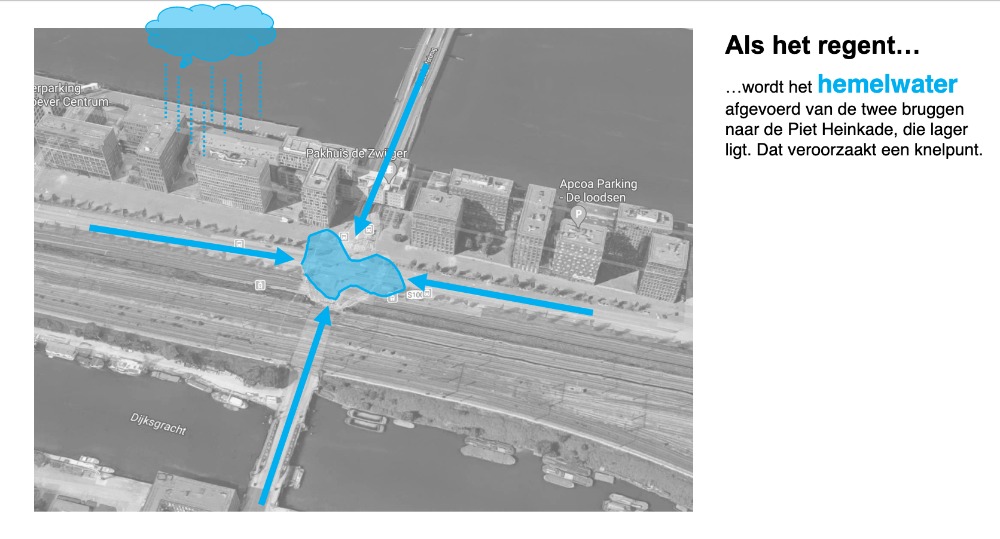
Voorbeeld probleem case Oostelijk Havengebied, Amsterdam
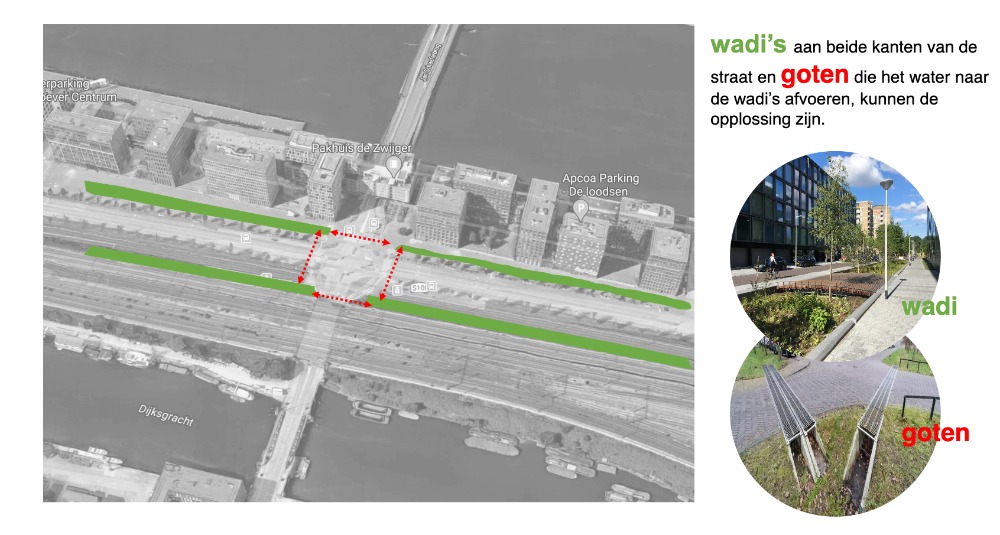
Voorbeeld oplossing case Oostelijk Havengebied, Amsterdam
Deltabeslissing ruimtelijke adaptatie zet druk
Van droogte tot wateroverlast, het speelt niet alleen in Amsterdam. De deltabeslissing Ruimtelijke adaptatie van de overheid stelt daarom dat heel Nederland in 2050 waterrobuust en klimaatbestendig is ingericht. Gemeenten, waterschappen, provincies en het Rijk moeten er samen voor zorgen dat schade door hitte, wateroverlast, droogte en overstromingen zo min mogelijk toeneemt. Dat is een grote opgave, stelt Klok. ‘Klimaatadaptatie is voor velen een nieuw onderwerp en dus nog niet zo vanzelfsprekend. Dat geldt ook voor de professionals bij de gemeente en Waternet. De noodzaak is hoog. Het klimaatbestendig inrichten van steden moet normaal worden, en wij moedigen dat met ons Leertraject Klimaatadaptatie aan. Vanwege succes gaan we binnenkort een tweede traject starten!’
‘Nog een leuk feitje’, sluit Klok enthousiast af, ‘is dat de opzet van het leertraject bijna één op één is overgenomen uit onze minor Klimaatbestendige stad die veel studenten trekt, ook buiten de HvA. Dezelfde docenten geven nu ook ‘college’ aan de professionals van die meedoen aan het Leertraject Klimaatadaptatie. Het is natuurlijk nooit te laat om te leren over het klimaat!’
Meer informatie Leertraject Klimaatadaptatie
Het Leertraject Klimaatadaptatie van lectoraat Water in en om de stad van Centre of Expertise Urban Technology heeft tot doel het kennispeil op het gebied van klimaatadaptatie binnen de gemeentelijke organisatie te versterken en beter te borgen. Na vijf cursusdagen, online excursies, praktijksessies en groepswerk aan weekopdrachten voor een klimaatadaptief ontwerp van een projectgebied zijn de deelnemers op de hoogte van de laatste ontwikkelingen en wetenschappelijke inzichten in de diverse klimaatadaptatiethema’s. En weten zij hoe ze met deze kennis de juiste maatregelen kunnen treffen in de openbare ruimte.
Stay up to date
Get notified about new updates, opportunities or events that match your interests.

